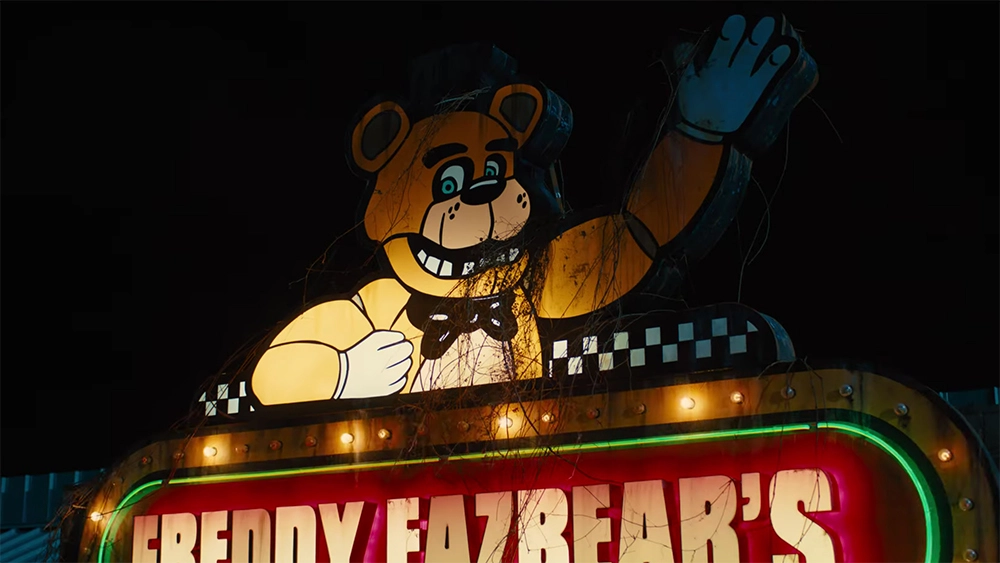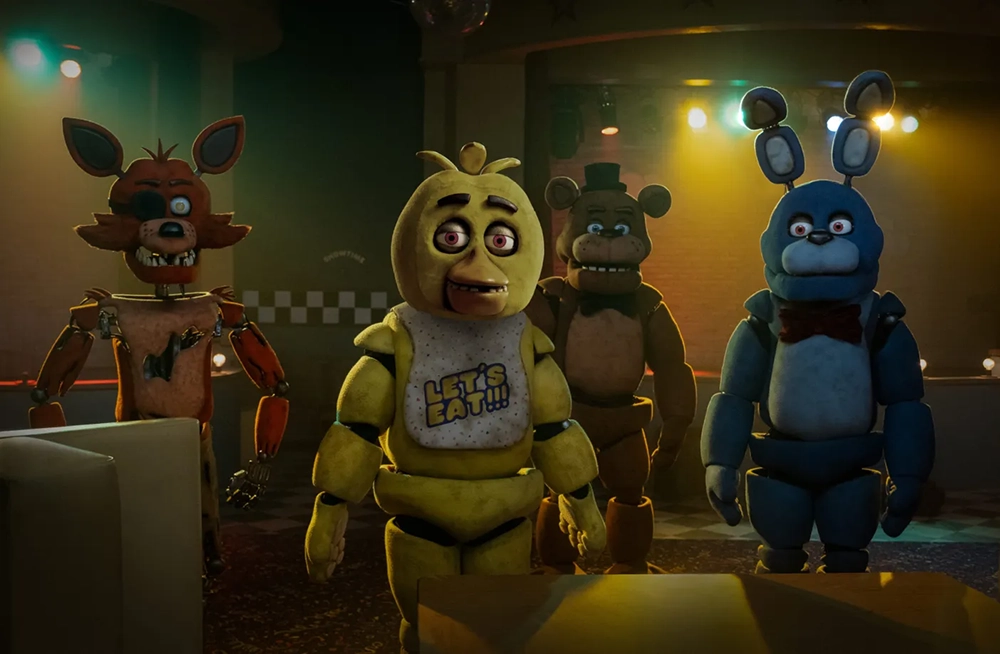Director Emma Tammi wants the viewer to spend “Five Nights at Freddy’s.” But it is essentially one night too many. The film fails to encapsulate the claustrophobic and tension-filled atmosphere that the classic horror video game had, instead relying on the most typical genre conventions crafted in the cleanest and most defunct manner.
Cinema and Videogames’ Fifty-Fifty Split
Videogames and cinema can connect with one another in some ways. But, when it comes to adaptations of these games in a big-screen format, that tie begins to fluctuate drastically, especially with ones within the horror genre. There have been plenty of franchises that have been translated into the cinematic medium in both positive and negative ways. And even so, it all depends on who you are asking. The fans and non-fans regarding those projects collide with one another due to their passion for such games. From the “Resident Evil” franchise (which is ridiculous and cheesy in an entertaining fashion) to “Silent Hill,” we have seen various horror projects seeing the light of day in theaters.
While people are excited before the projects arrive, when they finally arrive, a fifty-fifty split happens. Some will enjoy the movie because of its references and easter eggs to the game they love. On the other hand, most of these films aren’t any good because, first and foremost, they fail to capture what intrigues fans of the games. And the latest one, Emma Tammi’s “Five Nights at Freddy’s”, is yet another example of such. Most people know about the game, so I won’t bother much with over-explaining what it is about. It is about ghost children who have been trapped inside the body of animatronic robot animals. In the game, you have one job: stay awake and alert – survive five nights inside this pizza and arcade establishment. The problem is that these animatronics are out to get you.
The Unfortunate Welcome to Freddy Fazbear’s Pizza
What’s different here than in the game is that the person stuck in security has a background now. We follow Mike (Josh Hutcherson), who has been struggling to pay his bills and lost yet another job for assaulting a man he believed was a kidnapper. His past haunts him. Mike often tries to go into a dream state to find clues about what happened to his brother when he was younger. Of course, you immediately sense that this would be yet another film about a person’s traumatic experiences and how the forthcoming horrors will connect the dots—fixing him and his previous problems completely. Currently, Mike doesn’t have much of a choice. There aren’t many jobs available at the moment. However, one has popped up: a security night shift at an ’80s children’s establishment called Freddy Fazbear’s Pizza.
Think of it as a Chuck E. Cheese-like location, only creepier, dustier, and darker.
Of course, he says yes to the terrible post with even more terrible hours. What choice does he have at this moment? As soon as he opens the doors of Fazbear’s, everything has to descend into survival horror madness slowly. Yet, nothing ever really happens, at least in terms of spooks and scares worthy of the film’s Halloween release date. There are several reasons why “Five Nights at Freddy’s” failed to translate its scares and thrills from the video game format to the big screen‚weird tonal shifts, clunky dialogue, and an over-extended run-time. But there are too many important factors that made the film fail to fulfill its horror camp capabilities. The first one is the lack of a claustrophobic and suffocating atmosphere.
The Lack of Tension and Terror from a Claustrophobic Game
I haven’t played the game often, only for an hour or so. However, from my short experiences, I noticed a confined and tension-filled setting. The hallways were closing in as you entered the bowels of this broken-down pizza and arcade place. There’s a feeling that the animatronics are always watching you. As they close in, you feel anxious–worried about where they will pop up, either from the vents or the door you accidentally left open. Or even the power goes out. The nightmare bear named Freddy is already there. His music box is churning Georges Bizet’s “The Toreador Song.” And you know that it is over for you. All of those scenarios and sequences that I have just described are missing from Emma Tammi’s film.

You never feel scared, worried, or even anxious about these animatronics murdering anybody who enters the establishment. So, if there are no noteworthy or proper scares, what does “Five Nights at Freddy’s” offer? Well, if I’m completely honest, outside of seeing Matthew Lillard getting the money he rightfully deserves, nothing really. Emma Tammi often shows glimpses of its possibility with a couple of sound works and frames that are slightly scary, particularly for younger viewers. But they never translate into something worthwhile or live to the potential of their concept. This leads to my second point: the odd shifts in tone and changes to the original narrative.
Several moments completely baffled me because they took me out of the experience. And it comes with Emma Tammi’s decision to change the technique in which she introduces the animatronics. During the first scene and a break-in sequence, she covers the scene in dim lights. She focuses on the audience being attentive to the background and shadows, just like the game. Although these scenes weren’t groundbreaking, you see (somewhat), for the first time, the essence of the game on-screen. There is an array of elements being demonstrated that will have both fans and new viewers frightened—the glowing eyes, Freddy’s humming, the sound of the animatronics’ steps, amongst others. But, outside those two scenes, most of the film (or at least it felt like that) is shown through sunlight and a clean PG-13 lens.
One Night Too Many for Freddy and Friends
The latter refers to Emma Tammi’s desire to pave away from the tragic history that accompanies both the killer and the children in this tale. Of course, we get tons of unnecessarily excessive exposition dumps for the two different backstories—the main character and the establishment’s past. But Tammi never explores the crux of “Five Nights at Freddy’s” to its fullest and darkest possibilities. It wants to have that “Poltergeist”-like relation of children’s horror stories with a gruesome slight touch. However, the only glimpse you get of pain and terror is a classic blood-covered hand dragging across a window, a gag you can see pulled off better and more convincing at your local Halloween store or Party City.
The two stories eventually coincide with one another, yet not in a way that’s fascinating or enticing. It touches on the pet topic of most studio horror pictures: trauma. Horror fans aren’t completely tired of seeing this theme in film. We are just exhausted from getting vacuous and vague attempts at it, this one being one of them. Two years ago, we got a ripoff of the classic horror game via the Nicolas Cage-led “Willy’s Wonderland.” And although that wasn’t a good movie either, it did better justice to the concept. It never skipped a beat and went to the action quickly.
Sure, the references and easter eggs may be vast for fans. They screamed and pointed to the screen like this was their “Avengers: Endgame”-like cinematic event. Heck, even some attendees went in full (and impressive) cosplays to the cinema. But its poor handling of genre conventions and fluctuating tonal shifts, in addition to its unnecessarily two-hour run-time, make “Five Nights at Freddy’s” a very undesirable and frustrating watch. To put it plainly, it was just one night too many.
“Five Nights at Freddy’s” is now available in theaters worldwide and streaming on Peacock.



